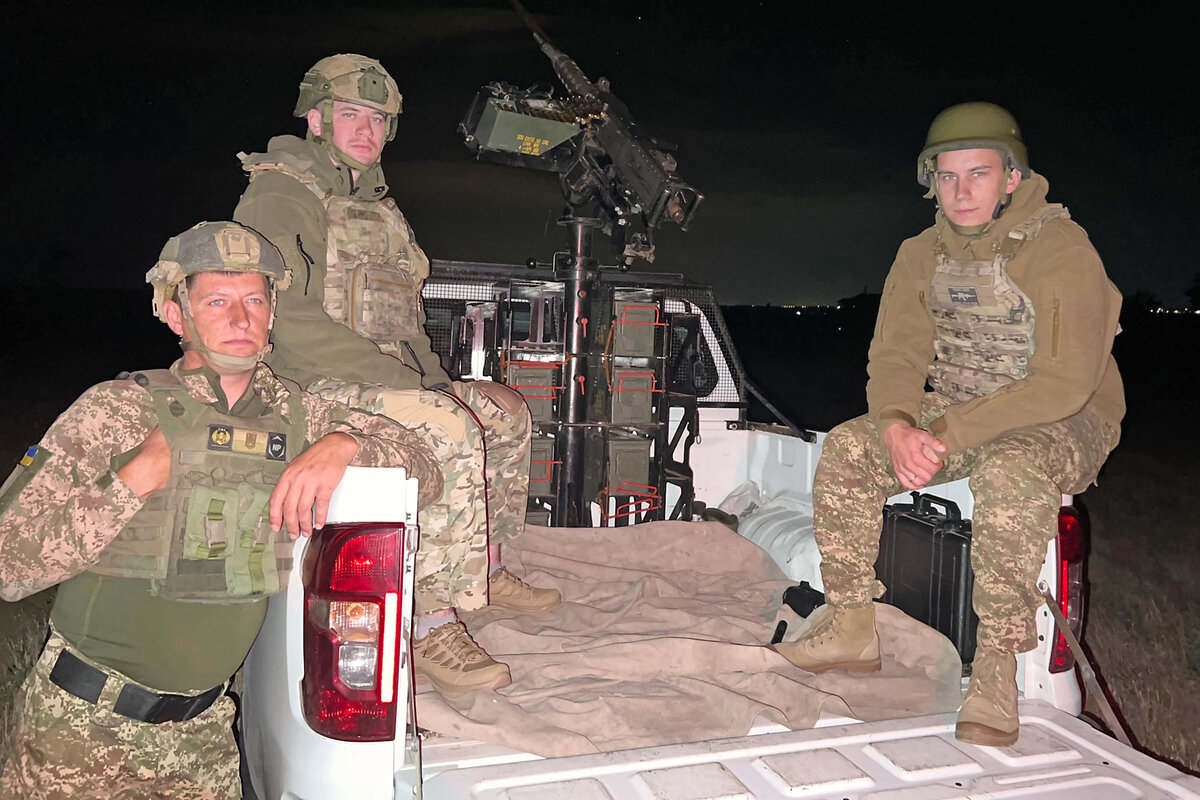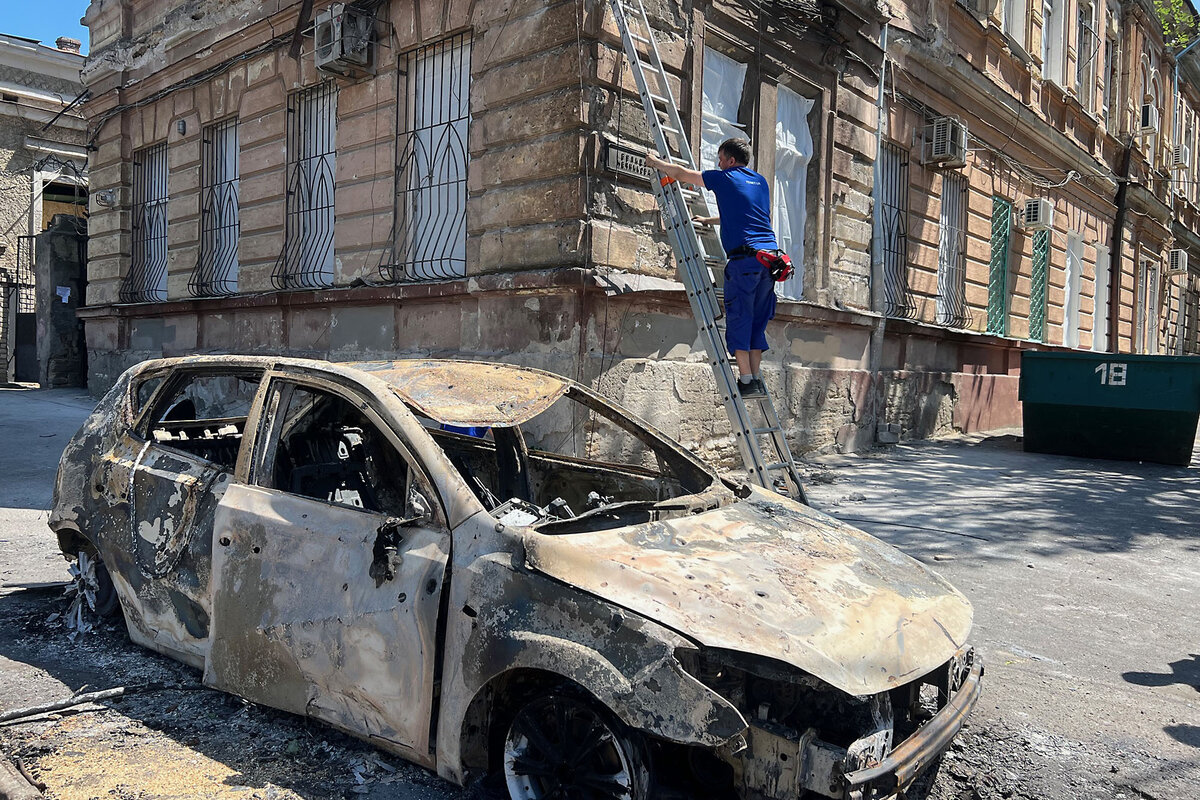Facing waves of Russian drones, Ukraine’s defenders fight frustration
Loading...
| Odesa region, Ukraine
On the steppes of southern Ukraine, a recent day’s last sunlight illuminates wispy magenta clouds to the west, while to the east Odesa’s lights give a faint glow to an otherwise dark sky.
In the middle of an expansive harvested wheat field, a late-model white pickup truck sits pointing east to the Black Sea, an American Browning M2 machine gun mounted in its bed.
The only sounds, other than from the occasional gust of wind, come from the muffled conversation of three soldiers. One stands in the truck bed adjusting the gun, while the other two, boots planted in the field, peruse a map on an iPad and scan the sky with a blue light that reaches 6 kilometers.
Why We Wrote This
With Ukraine’s air defense systems overwhelmed by a surge of Russian attacks, mobile antidrone teams have emerged as an indispensable defensive line against the onslaught. But for the defenders, the nights can be long, the successes too few.
The soldiers, from the Ukrainian National Guard’s 11th Brigade, comprise a mobile antidrone unit, one of dozens of such units operating this same night across Odesa, a region slightly larger than Maryland.
The men’s assignment: Track and shoot down the drones Russia is sending into Ukraine in skyrocketing numbers. In a war in which drones now carry out more than 70% of all attacks, antidrone units like this one have emerged as an indispensable – if insufficient – defensive line against an intensifying Russian onslaught.
“This type of unit is one of the most effective ways to protect against the drone attacks that have become more frequent, larger in numbers of drones, more sophisticated, and of course more deadly over the past year,” says Andrii, call sign Hans, the unit’s commander and gunner. He and others withheld their last names.
New U.S., European assistance
The mobile antidrone units have risen in importance as Ukraine’s other air defense systems have been overwhelmed by a surge of Russian attacks. In June, Russia launched 239 ballistic and cruise missiles, primarily targeting Kyiv and other Ukrainian cities.
Russia has been purposely acting to deplete Ukraine’s air defenses, including U.S.-provided Patriot antimissile systems, Ukrainian military analysts say – especially as doubts grew in early June over the Trump administration’s willingness to continue supplying the Ukrainian military.
Last week, President Donald Trump said he intends to continue military assistance; he specifically mentioned Patriots as he declared that Ukrainians “have to be able to defense themselves.” On Friday he said Patriots would be sent to Ukraine, with several NATO countries paying for them.
In a meeting Monday at the White House with NATO’s secretary general, Mark Rutte, Mr. Trump followed that up with a threat to impose “very severe tariffs” on Russia if there was no peace deal with Ukraine within 50 days.
European countries are also supplying Ukraine with additional missiles and artillery shells.
Record numbers of drones
“These guys may not look too scary, but the Russians would prefer to avoid us,” says Hans, injecting a bit of humor into his assessment of his antidrone team. Vlad, call sign Student, the spotter, “is pretty good at tracking what they send our way,” he says, while driver Oleksii, call sign Kalash (for Kalashnikov), “gets us where we need to go.”
Night after night (and less frequently during the day) where they need to be is in front of the ever-building waves of drones in ever-expanding varieties – kamikaze, munitions-laden, surveillance, decoy – that Russia is sending into Ukraine on an almost daily basis.
On July 9, Russian forces launched 728 attack and decoy drones in a single night, setting a new record after several nights in June had experienced previously unprecedented barrages of more than 500 drones each.
The one-night onslaught of 728 drones surpassed many of last year’s one-month totals.
Indeed in June, a new record was set for the number of long-range drones launched into Ukraine in a single month – 5,438, according to the Ukrainian air force. More than 230 people were killed in the June attacks.
Over the past year, more than 24,000 drones have targeted Ukrainian cities and villages, residential buildings, schools, and industrial sites, according to a study by the Center for Information Resilience, a U.K.-based open-source investigations organization.
In Hans’ view, the explanation for the explosion of drone use by both sides in this war is largely economic.
“I’d say it’s the relative cheapness of these things that is making them the weapon of choice,” he says. “At 20 or maybe $25,000 a drone, you can send a wave of 20 or 30 or 40 of them and still not hit the $1 million cost of one ballistic missile. Plus,” he adds, “the drones flying in large quantities are more terrifying for more people, and they can be more deadly.”
Numerous analyses suggest that the Iranian Shahed drones that Russia began purchasing last year (and which it now produces domestically under a billion-dollar contract with Tehran) cost more than Hans estimates. But decoys, reconnaissance, and lighter munitions carriers are cheaper.
Waiting in the darkness
Suddenly the unit’s iPad reports that two groups of drones have been launched: one from occupied Crimea, one from the Russian region of Krasnodar. With possible trajectories suggesting the port city of Odesa and the surrounding region could be the target, all the team can do is watch and wait.
Student, the spotter, says yes, of course he’s doing his job in the service of all Ukraine. But then he grins and adds, “The truth is this is also personal.”
A year ago, the young Zaporizhzhia native was at the front in the embattled Donetsk region when a Russian FPV drone fired on the armored vehicle he was riding in. Wounds he received forced his reassignment from combat.
“My parents are proud of the job I’m doing here, and I know what we’re doing is important. But I’ll admit,” he says, looking east toward Russia, “I want my revenge.”
He is still waiting. In the year this team has been working together, they’ve shot down three drones.
“I know it sounds like a small number,” Hans says, “but considering the density of units like ours around Odesa, our presence in the chain of units is important.”
Over the past year, drones have advanced to be able to change altitude on command and veer away from detected antidrone guns, the commander says, making hitting them more difficult.
As the three men sip coffee prepared on a one-burner stove, they acknowledge the frustration and disappointment they feel when drones strike and kill in the vast region – Ukraine’s largest – that they are defending.
Driver Kalash says he feels all the more protective of the Odesa region as it is his home.
“When you know a drone is approaching, part of you just wants to run home and protect your family, but you also know your job is to do your best for everyone’s security,” he says. “When the drones do get through and especially if people are killed, you just feel an anger,” he adds. “You realize that despite your best efforts, it’s never enough.”
“They are our hope”
Indeed, just two nights earlier, a Shahed drone smashed into a residential building in Odesa’s historic center, killing one woman, destroying numerous homes, and burning cars.
At the site of the June 17 strike, some neighbors leave floral memorials to the deceased. Some express frustration more can’t be done to stop the attacks.
“I realize it’s getting harder to shoot [the improved drones] down,” says Mykola, an unemployed information technology worker whose car was engulfed in the fire the drone touched off. “But why can’t the measures to take out the drones improve as well?” he adds. “Maybe they need more than machine guns to do the job.”
But others are grateful the antidrone units are out there, even if they don’t stop everything coming in.
“Honestly, we as Ukrainians are praying every day for all our soldiers to be able to do their work and survive this terrible war,” says Nataliia Cherniuk, a cheerful woman who sports a “Stay True” T-shirt who has come to check on a friend’s damaged apartment.
“They are our hope,” she says of the antidrone units. After a pause to survey the damage, she adds: “We just know they are doing their best.”
Back at the truck, the unit’s iPad shows the drones veering off, no longer threatening Odesa.
Four hours after setting up, the screen shows no new launches, and Hans sums up the situation for his men: “It looks like it’s going to be a quiet night.”
Oleksandr Naselenko assisted in the reporting for this story.







